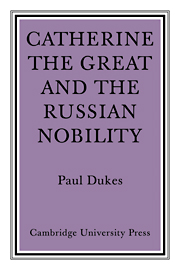 Catherine the Great and the Russian Nobilty
Catherine the Great and the Russian Nobilty 1 - Crown and nobility in Russia before 1762
Published online by Cambridge University Press: 31 March 2010
Summary
The Russian imperial autocracy could not have survived the eighteenth century without the support of the dvorianstvo, or nobility. Even the more capable and diligent among the rulers at this time, Peter I and Catherine II, needed to foster this class to maintain and exercise their power, and during the other two long reigns of the century, those of Anna and Elizabeth, the business of government was almost entirely handled by favourites and members of the nobility. Both these Empresses, it is true, made their peculiar impact on the statute book, but neither deserves the attention that their illustrious predecessor and successor merit in the field of legislation. Anna liked hunting, and so issued personal decrees prohibiting the pursuit of certain animals and birds in regions which she chose to reserve for her own pleasure. She was upset by the sight of a funeral procession passing her window, and forbade the transport of corpses past her palace. Elizabeth was very fond of clothes, which prompted her to require merchants to show her the fine materials they imported before putting them on the open market. She shared Anna's aversion to unpleasant reminders of mortality, and required the graves in cemeteries on the road to one of her residences to be more firmly sealed to stop any odour emanating from them.
- Type
- Chapter
- Information
- Catherine the Great and the Russian NobiltyA Study Based on the Materials of the Legislative Commission of 1767, pp. 1 - 37Publisher: Cambridge University PressPrint publication year: 1967


